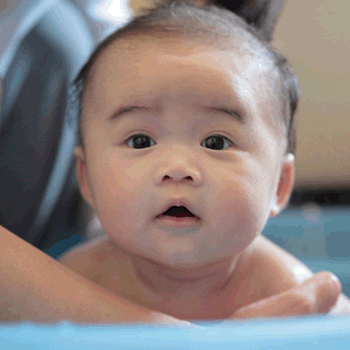Bathing Your Baby
Many new parents are shocked to find that the first few bath experiences for baby may be downright frightful! As baby wiggles and hollers, when you are bathing your baby you may be tempted to think, “Didn’t you just spend the past 40 weeks in a warm water bath of sorts in my tummy?”
Over time, however, babies typically come to love their baths, and it’s a great bonding time for parents and baby. Follow these simple steps to set the stage for success with baby’s bath each and every time
Simple steps to a great time bathing your baby:
Never leave your baby even for “just for a minute…”
Bathe baby before feeding to reduce the risk of their having a bowel movement during her bath
Don’t bathe your baby every day – two to three times a week is more typical; daily bathing can cause skin irritation and remove your baby’s natural moisture barrier. Daily, gently wipe their genital and rectal areas at each diaper change with warm water, and wash their face and neck areas after feeding also with warm water.
Gather the needed supplies ahead of the bath – including warm towels, a soft wash cloth, rinse water, diapers and clean clothes ahead of time.
Bathe baby in a warm room free from drafts and moving air.
Fill a tub, sink or basin with warm water and have it ready to go before you bring baby to the bath. Use warm water for bathing; check the water temp with a thermometer if you have one, it should be no more than 100.4 degrees Fahrenheit..
Avoid soaps, and instead choose gentle, preservative-free cleansers designed specifically for tender infant skin with a neutral pH to decrease the risk of skin irritation.
Support baby’s head and neck in your forearm at all times. Lower baby into water deep enough to cover their shoulders and cover their body with a warm wash cloth to help keep them warm.
Managing cradle cap, which shows up as scaliness and redness on baby’s scalp. There may also be some redness in the folds and creases around baby’s neck. When you see scales and redness on baby’s head only, that’s called cradle cap. It can also show up on baby’s face and in their diaper area.
Baby is likely unbothered by this as it’s seldom irritating or itchy. You can shampoo baby’s hair with a mild baby shampoo until the scales fall away. You can also use a very soft brush to gently loosen the scales and help them along more quickly. Avoid putting any ointments or gels on the scales–if the scales are getting worse, talk to baby’s healthcare provider, who may prescribe a cortisone cream.
Is it a yeast infection? The redness you see on baby’s skin, especially in the creases and folds, is more likely a yeast infection–now that can be itchy for baby. Your baby’s healthcare provider will likely prescribe a cream safe for babies after evaluating the redness.
Immerse baby’s umbilical cord; it’s OK to get baby’s umbilical cord wet unless your baby’s healthcare provider has given you reasons not to immerse the cord.
Clean from top to bottom, starting with baby’s face, and move down and around baby’s body, cleansing their diaper area last. Begin with baby’s eyes, sweeping from the inner to outer areas of their eyes. Use a fresh and clean corner of the washcloth per eye as this helps to reduce the risk of an infection spreading from one eye to the other.
Wash baby’s hair and massage their scalp – you know how good this feels at the salon – so give baby that same gentle fingertip massage too.
Lift baby’s chin to clean between their neck folds where milk or formula often collects.
Clean baby’s diaper area from front to back for females, which reduces their risks of cystitis. For ababy boy, lift and gently clean the scrotum and cleanse the area. Remember, never retract the foreskin of a baby boy with an intact penis.
Then begin the rinse; move from top to bottom to complete the bath. Gently lift baby from the tub or basin and wrap them in a warm towel and begin gently patting baby dry. Dress baby in a clean diaper and add some warm, snuggly clothes. Snuggle time!





Comments are closed.